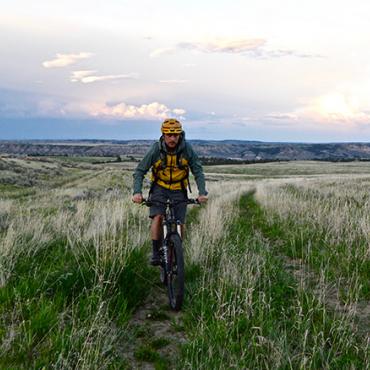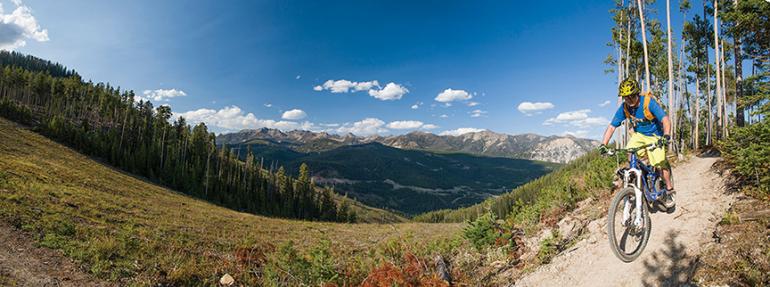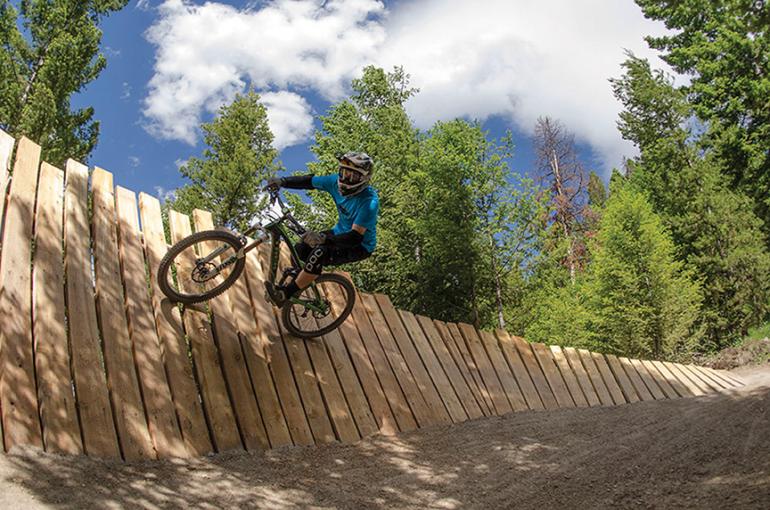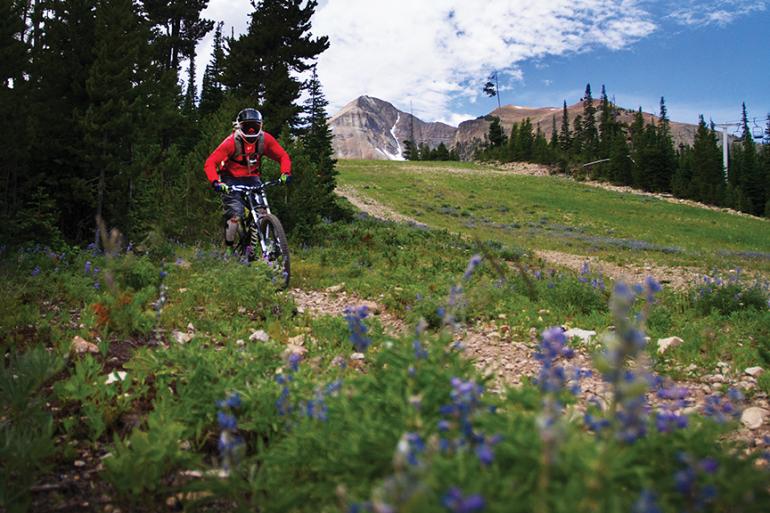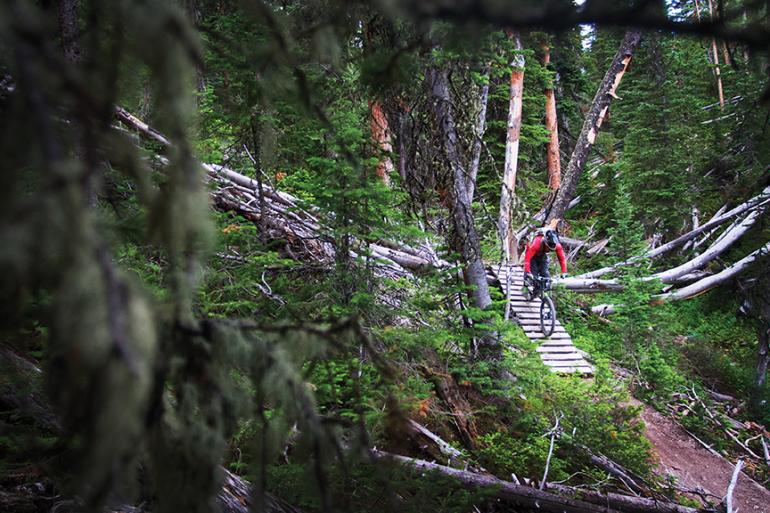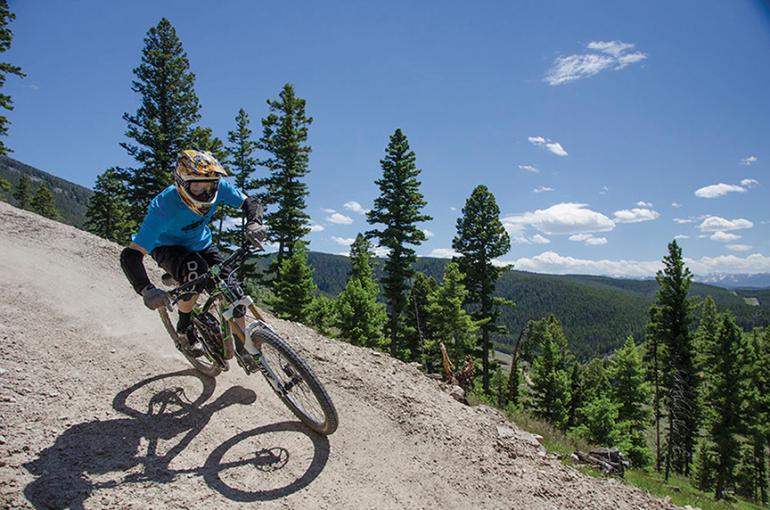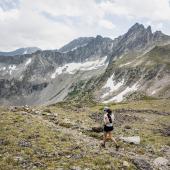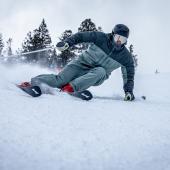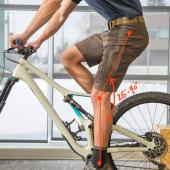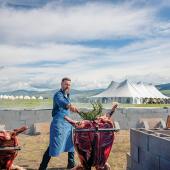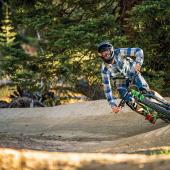Biking Boom
Downhill riding gets a boost in the Big Sky.
There are downhill mountain-biking destinations in North America whose mention conjures images of loamy trails with hand-finished berms and painstakingly designed freestyle features—where trains of smiling, wide-eyed bikers weave and undulate, testing the limits of gravity and the limits of their nerves. Montana has never been one of these places. Unfortunately, Big Sky Country induces PTSD-like flashbacks of grueling climbs, ball-bearing-slippery scree gardens, and hold-on-for-dear-life steeps. While the cross-country and trail riding around Bozeman is solid and getting better all the time, the downhill mountain-biking scene has languished. Less-than-ideal terrain, prohibitive expenses, and neglected infrastructure are just some of the hurdles to establishing a dynamic downhill community, and southwest Montana has struggled with all three—until recently.
Technology has brought the cost of bikes down, making burlier rigs available to more people. Substandard winters have convinced resorts to invest in summertime activities to generate revenue and attract new customers. And trail-building has developed, becoming more of both a science and an art form, which has allowed for awesome trail systems in terrain that wasn’t previously suited for anyone but the most expert of the experts. All of this has led to a biking boom in southwest Montana that promises to have folks anxiously awaiting first chair not just all winter, but all summer, too.
Big Sky
Steep, rocky, technical: these are some of the adjectives folks often use to describe downhill biking at Big Sky.When I tell them I’m about to ride there for the first time, a sympathetic smile spreads across their faces. “Hold on tight,” they seem to say. With that unsettling thought in mind, I drive up the canyon from Bozeman to see what all the fuss is about.
“Where have you ridden downhill before?” our guide Adam asks, as he passes out body armor and full-face helmets. “Vermont,” I reply sheepishly, “but I used my cross-country bike.” “That wouldn’t work here,” he says, politely holding back laughter.
A cursory glance at Big Sky’s summer trail map suggests that unless you were born on a bike, and have ridden every day of your life, you have no business on this mountain. Being that the majority of the map’s squiggly lines are black and anchored by twin diamonds, it’s only natural to view the terrain as experts-only riding.
But all that is changing. “With resorts, variety is key, and Big Sky will have that,” says trail-building connoisseur Pete Costain. Pete was hired by the resort to implementa mountain-biking trail planthat could change the way people experience summer on Lone Mountain. Founder of Terraflow Trail Systems, Pete and his crew have been busy the past several years revitalizing trails across the Northern Rockies, and he believes Big Sky has the most upside. “Big Sky could be top dog,” Pete says, obviously excited about the mountain’s potential.
That potential will be on display this summer as new trails get perfected, several of which service beginner and intermediate riders. From the top of the Explorer chairlift, Big Sky’s lone green run, Easy Rider, winds along gentle grades and bermed corners. After a few warmup laps, I move on to the new flow trail, Otter Slide. Most riders, myself included, would be happy lapping the manmade step-ups and table-tops all day, the trail’s design making both brakes and pedaling obsolete and allowing riders to simply “flow” along.
Mountain biking, like all sports, is constantly evolving, and flow trails are driving the sport’s development, especially at resorts. “Resorts are where flow trails belong,” says Pete. “We aren’t talking aboutremote backcountry experiences. We want the trails to service all needs, from beginners to experts.”
Terraflow is applying that all-inclusive mindset beyond the resort’s base area. Long-term plans include trails that will link the Madison area on the Moonlight side all the way down to the Meadow Village. Guests can already ride connector trails uphill or down from Moonlight to Big Sky, which immediatelyexpands the scope of rideable terrain because of Moonlight’s existing cross-country trails. “Moonlight is a key component in all this,” explains Pete, “and so is Spanish Peaks, which now has connector trails linking it to the Mountain Village.” Eventually, connector trails will link Moonlight to Big Sky to Spanish Peaks to the meadow.
Listening to Pete describe Big Sky’s mountain-biking potential, I imagine what a summer day might be like in the not-so-distant future. I’d grab a coffee at the base area, then hop on Explorer and warm up with a lap on Otter Slide. I’d loosen my legs with the gentle climb up the Big Sky-Moonlight connector and spend the morning riding cross-country. Feeling adequately warmed up, it’d be high time to let the chairlifts and shuttle buses do the hard work for me, so I’d cruise back down the connector to Swift Current and scare myself with some downhill, grabbing a beer afterward to calm my nerves. Then I’d pick my way down manicured trails to the meadow for lunch, or possibly “linner,” depending on how long I’d dawdled on the cross-country trails at Moonlight. Thoroughly exhausted, I'd hop on the Skyline to return the parking lot.
“The idea is to create connectivity a la Europe, and to develop more sustainable systems using the disjointed series of trails that exist now, including everything from the Moonlight side, Big Sky’s downhill trails, and even forest service trailheads,” says Pete, whose contagious excitement has me googling “downhill bikes” looking for deals. “The future is bright here at Big Sky.”
However bright that future is, the resort will have to work hard to convince people that Big Sky is mountain biking’s Shangri-La. Its reputation as steep and rocky leads people to look elsewhere for their gravity fix, but Big Sky is taking steps to change that. This year, along with rentals, they’re also offering instructional classes and guided tours. Instead of just being a gateway to Yellowstone, the resort is hoping to become a summer destination for downhill biking as well.
Discovery
Big Sky isn’t the only game in town, however, and if you’re talking downhill biking in southwest Montana, you have to mention Discovery. Two and a half hours from Bozeman, this mom-and-pop ski area transforms into an oasis of bermed turns, giant freestyle features, and smile-inducing singletrack. Like Big Sky, you can pay a small fee and ride singletrack all day, or pony up for a lift ticket and rip downhill trails. Also like Big Sky, Discovery developed its biking infrastructure in an effort to become a year-round destination. So far, the gamble is paying off, with more and more Bozeman riders making the drive to Philipsburg on summer weekends for their lift-accessed biking.
Whitefish
One be equally remiss if he left the Whitefish Bike Park out of this discussion. While it’s certainly not in southwest Montana, the world-class trail development at Whitefish deserves a brief mention. The resort’s Kashmir trail was recently named a top-four flow trail in the world by the International Mountain Biking Association. Again, the pros at Terraflow had their hands in the dirt building this park and it’s worthy of a long-weekend road-trip this summer.
While chairlifts will continue to carry far more skiers than bikers for the foreseeable future, downhill riding is growing in popularity. As ski areas scramble to deal with low-snow years, they hope summer activities can augment winter revenue, making resorts financially viable. As the economics of bike parks start to make more sense, infrastructure will improve, making the sport more appealing to more people. As more people start to ride, resorts will reinvest in their bike parks, and so on and so on. Montana isn’t Whistler and never will be, but what we have is getting better, and for bikers, that’s good news.


